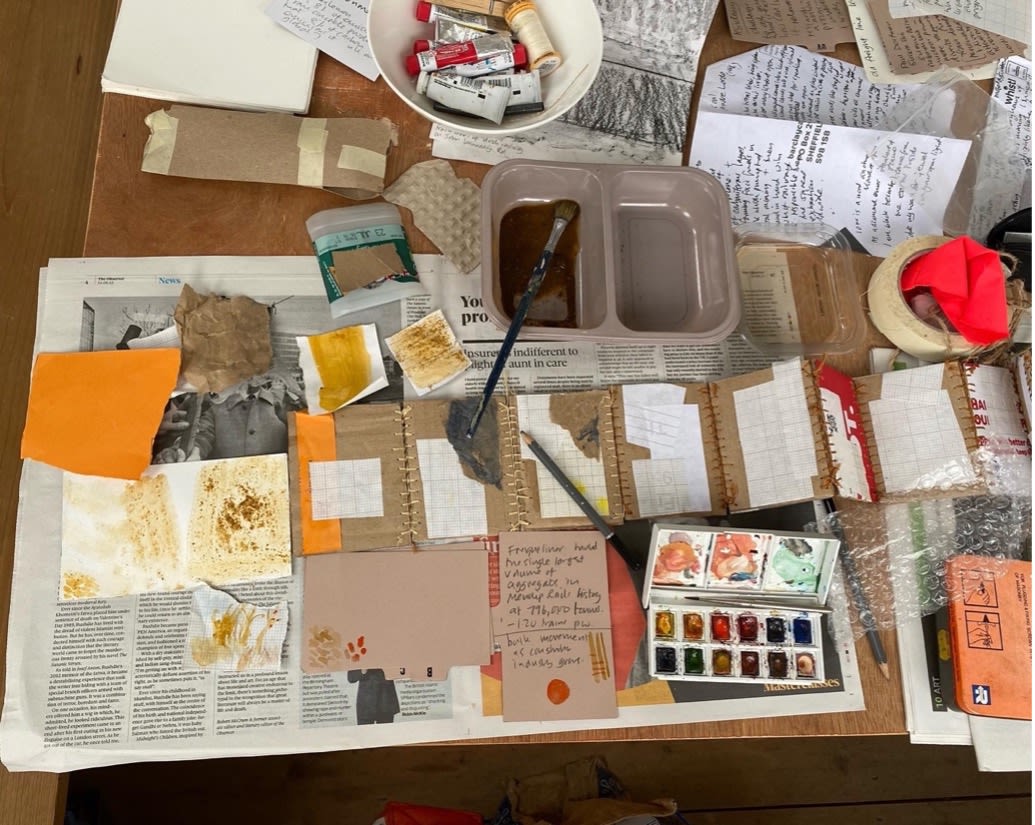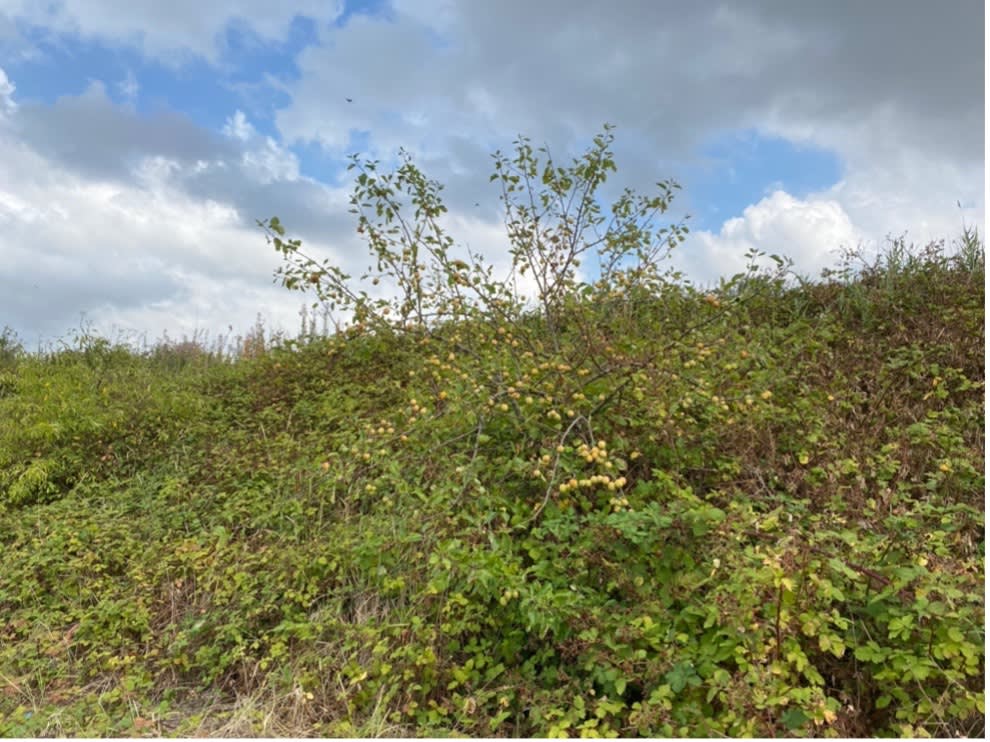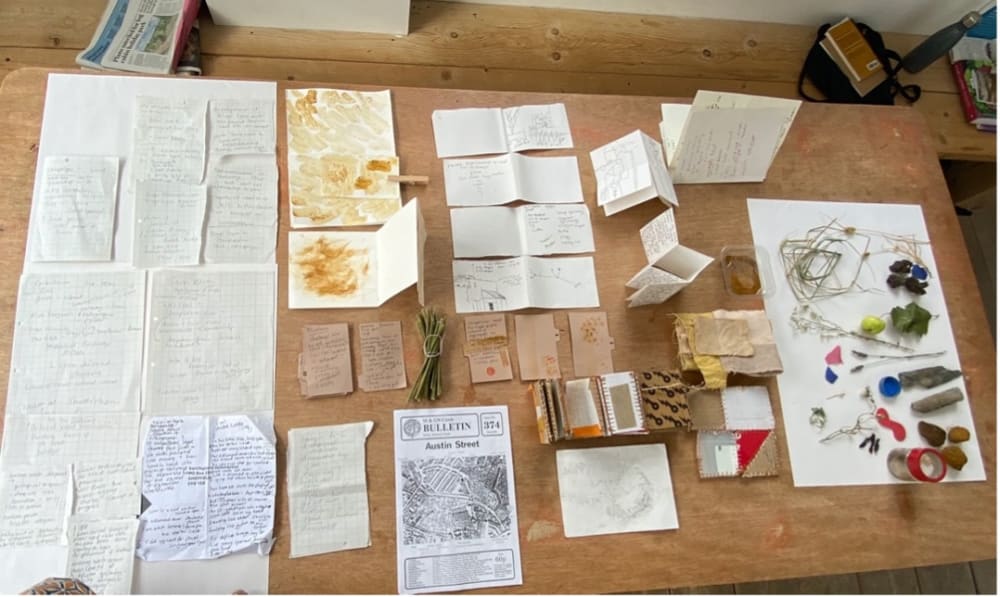
Sara Grisewood reports back on her AER Residency at GroundWork Gallery

- Written bySara Grisewood
- Published date 19 October 2022

Sara Grisewood, PhD Candidate at Chelsea College of Art was selected for the AER residency at GroundWork Gallery, Norfolk, UK, and reports back to the Post-Grad Community.
Set up by Professor Lucy Orta UAL Chair of Art for the Environment - Centre for Sustainable Fashion in 2015, The Art for the Environment International Artist Residency Programme (AER) provides UAL graduates with the exceptional opportunity to apply for short residencies at one of our internationally renowned host institutions, to explore concerns that define the 21st century – biodiversity, environmental sustainability, social economy, and human rights.
Sara's Report
Reading through a daily diary of the residency it has many references to ways of moving around: transit systems for humans and morethanhuman. The theme of Extraction: Loss and Restoration links in with my research into freight lines, those in use and disused ones. The residency was an opportunity to bring together aspects of my research in a place criss-crossed by many different narratives: visiting a local silica quarry which uses a freight line, and within the town and outskirts there are visible traces of disused railways, amidst layers of industrial history, and the history of King’s Lynn as a medieval port. I spent much time working out how I could get to places by bus and walking in and around the town. I visited archives at King’s Lynn Library and at True’s Yard Fisherfolk Museum. I have included here some extracts from the journal which highlight the key themes.
Tim Holt-Smith the geologist working with GroundWork Gallery touched on the debate around the definition of the now universalising term Anthropocene. This prompted questions around the discovery of carboniferous layers forming fossil fuels in the UK which prompted coal mining and, of relevance for my research, went hand-in-hand with the acceleration of railway building. In turn this was part of colonialism and the ongoing impacts of imperialism and global capitalism. On the train with me now I have Kathryn Yusoff’s A
Billion Black Anthropocenes or None to remind me that the debates around the definitions of Anthropocene are much more complex:
The Anthropocene might seem to offer a dystopic future that laments the end of the world, but imperialism and ongoing (settler) colonialisms have been ending worlds for as long as they have been in existence. The Anthropocene as a politically infused geology and scientific/popular discourse is just now noticing the extinction it has chosen to continually overlook in the making of its modernity and freedom.
15th August - Day 1
As I left Lewes Station this morning a freight train carrying lots of aggregate came through, from Newhaven. Had it been extracted from the Channel: and where was it heading? It represents part of the endless shifting around of extracted materials to feed road building and other huge infrastructure projects such as Hs2.
Later I went on my own for a walk; to start exploring evidence of train lines and goods yards in King’s Lynn. I walked along the side of the railway by Morrisons looking for a view of the side of the train line as it goes in to King’s Lynn Station. I kept on walking and found a good view of the disused Dock Branch goods line.

18th August
I use walking as a kind of research process. How best to record it? I made notes on lots of pieces of scrap paper or in handmade booklets; I made a drawing and bits of writing in a little folded book on Boal Quay. Later on I met someone, a local historian who said it was named after a Portuguese wine which evoked the legacy of King’s Lynn as a wealthy Port in medieval times. I talked to Veronica about the development plans for this area and I thought of the little apple tree, the remnants of the train track, the coiled blue plastic piping, the two fishing boats. How to mark the lives and stories, nonhuman too that have resided here?


Tuesday 16th - Day 2
In the morning I walked up past Tuesday Market Place and on to look for traces of the Dock Branch Railway line on John Kennedy Road and found the metal rails crossing the road and could just make out the red circle sign in the gates of the old level crossing through the overgrown ivy. I made some rubbings of the train line as it went across the pavement and disappeared through a mass of ivy. The road was busy with cars though so it was tricky to spend too long drawing on the pavement.

Afternoon: Visit to Middleton Aggregates
Extract:
Peter Lemon of Middleton Aggregates, thinks quarrying will always continue as people need houses. Is it necessary to keep building new?
He, Peter Lemon did give some sense of caring for the land and creating nature reserves once the quarries are spent. At the end of our visit he drove us around a reinstated quarry, ‘returned’ to nature, for fishing, for wild swimming, but I felt it was nature for human use, not nature for the more-than-human. It will never be restored as such; it took millenia to create those habitats
Wednesday 17 - Day 3
Walking around the town It was all a bit weird as gradually I realised that many of the shops could not open because of flooding. Heavy rainfall and flash floods.
I found a charity shop with a kind man mopping a wet floor; they had a special railway section. I also found an older, maybe 1970s, street map of King’s Lynn which had the railway branch lines on.
Visit to Sibelco
Maybe because it was just Karen and I, Simon Penny at Sibelco, let us explore the disused, ruined station; there was a dilapidated platelayers hut with the old stove in it. I stood on the track; it was like a railway on a beach, covered in sand. I took photos of plants and of the big hopper that drops the sand down into the railfreight wagons. There was no loading just now; it only happens in the mornings, six days a week. Just now it was deserted; there were lots of wildflowers and birds flitting across the tracks. It was a unique experience to sense and be in the old station, abandoned, and yet also used as part of an ongoing extraction process.
Friday 19 August - Day 5

I went back by bus to Middleton Towers. On the road walking, it was narrow and there were mostly no verges so I went into adjacent fields where I could and walked through stubble and also beet; but at certain points I couldn’t and had to walk along road. There were so many large lorries, all coming to and from Sibelco. I then came to the crossing which was a bit of an amazing moment. I could see the wagons of the freight train under the big hopper at Sibelco, where we had stood the other day. It was only 11.15 so I had a while to wait. It takes a long time to fill the wagons.
I hung around in the garden and derelict land around the disused station; I recorded the plants and did some drawings. It was very peaceful spot, apart from the noise of road traffic. I was technically trespassing and a big sign said I could be fined up to £1000 but I actually felt safer here off the road and away from the huge trucks. I could still hear a kind of whining sound of the sand filling the wagons. This then changed and I could hear something different. I went to the level crossing and saw the red GB freight locomotive ready to pull the wagons, coming to the front, on another line. I watched the whole long freight train move, no more than 5 mph through the lavender in the front garden of the cottage.

Saturday 20th - Day 6
I cleared up and laid out the research, drawing, found objects etc. from the last few days on the big table for the Meet the Artist event in the gallery; it was good to see what Ive done so far. Interesting visitors; including a councillor who talked about living in Watlington as a child, helping her father load strawberries and runner beans on the train to go to Covent Garden in London.

Monday 22nd - Day 8
I went out early to see if I could spot the freight train carrying sand from Sibelco arriving into King’s Lynn. It was in the siding as I walked up to Tennyson Avenue, to the level crossing and I waited there for an hour until it left. It was exciting to see it again, leaving King’s Lynn. Also to see the signal box, and the flowers growing all over the tracks by the level crossing.

I spent a couple of hours in King’s Lynn Library looking through books and archives on local railway history and ordnance survey maps. The librarian pointed me in the direction of the original Government Acts granting Assents for the Railway Companies; with lists of goods and charges per item. For example:
Out walking I tried to find the other end of the freight line. I had some good sights of the old goods lines, and of the town wall along Kettlewell Lane, then a really hidden, overgrown bit by following footpaths. Seeing the actual remains of the line helps fit everything together, like a jigsaw. The big goods sheds, depots and yards, and sidings, and cattle pens, and malthouse, are all gone and now a huge supermarket stands where they used to be, which sums up how reliant on road transport our food systems are now. Walking through the car park and looking for the freight line round the back, I imagined it in the future, not as a car park, but as shared allotments and a central hub for local food distribution.
Tuesday 23rd August - Day 9
I did some sewing of the pages. Identified alder from bus stop yesterday. Shall I keep or make a dye? The oak and acorns produced such a strong dye. I am using these dyed pieces to sew on to the hiviz jacket. Also I am making tracings of the lines of trains, including goods trains coming out of King’s Lynn.
I really like the way the diagrams of lines going into stations, old ones with lots of sidings, marshalling yards and goods depots, look like plants or river estuaries.

Overall, the theme of Extraction: Loss and Restoration enabled a positive and rich opportunity to engage with key aspects of my PhD research: sense of place and the local, railways, extraction, freight lines and industrial history.
The residency, live/work space really suited the way I work. The location in the town enabled my walking, a kind of purposeful wandering, while drawing and writing notes, on handmade booklets and scraps of paper. A collecting of bits and pieces: parts of stories, hidden, overlooked places and narratives.

I vividly imagine futures, and these speculative fictions are ways for me to imaging restoration. For me the concept of restoration is very much to do with imagining and envisaging future transport and infrastructure systems which work symbiotically with the morethanhuman and land.
I would like to include here a big thank you to Veronica for organising the residency and the opportunity to meet the other artists.

I have added here some images from the exhibition. The residency finished on the 28 August and the show opened on the 2 September.



Related Links
- Art for the Environment International Residency Programme (AER)
- GroundWork Gallery
- UAL Centre for Sustainable Fashion
- UAL Post-Grad Community
- Sara's Instagram
Art for the Environment Residency Programme
The Art for the Environment Residency Programme (AER) provides UAL graduates with the opportunity to apply for a 2 to 4 week fully funded residency at one of our internationally renowned host institutions, to explore concerns that define the 21st century – biodiversity, environmental sustainability, social economy and human rights.
Founded in 2015, internationally acclaimed artist Professor Lucy Orta, UAL Chair of Art for the Environment – Centre for Sustainable Fashion, launched the programme in partnership with international residency programmes and UAL Post-Grad Community.